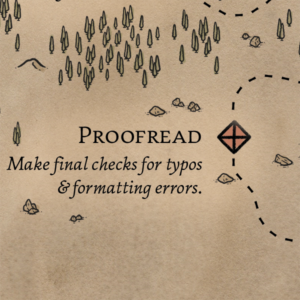 After your trek through the woods of design and copyediting, pause and catch your breath. Now is the time to proofread your work before you launch your voyage into the sea of publishing. Proofreading is a final check to make sure your gear (your words, design, etc.) is in order before publishing.
After your trek through the woods of design and copyediting, pause and catch your breath. Now is the time to proofread your work before you launch your voyage into the sea of publishing. Proofreading is a final check to make sure your gear (your words, design, etc.) is in order before publishing.
Final Checks & Preparations
Proofreading is a time of fine-tuning and minutiae. It is not a time for major course corrections. You’ve already revised the plot, infused each line with lyricism, and even copyedited for inconsistencies and grammar errors. Proofreading fulfills a narrow role after all those other types of editing.
Proofreading emphasizes three major tasks.
- Verify everything is as intended. This means checking that all the text the author wants included is included. Proofreaders make sure any placeholder text is replaced with the real, ready-to-publish text. They check to make sure all the frontmatter and backmatter are there—in the right order—as the author or publisher requested.
- Check for missed errors. Proofreaders also serve as a backup to the copyeditor (and every other editor, reader, or author) who previously checked the book. The truth is that no book is published with no errors. (Even if it were, some readers wouldn’t believe that because “correct” language is not an immutable monolith, and they’d find things that don’t agree with their version of English.) But a proofreader serves as a final opportunity to find things that have slipped through the net. Their recommendations should be restrained and work to fix the problem with the smallest possible change.
- Check the formatting. Proofreaders’ last primary task is to check all the formatting. They make sure everything is in the right font throughout the whole book, check for word stacks and other typesetting issues, and more. All the layers of editing have helped filter out more and more errors, but so far your book layout designer has been the only one to review the design. Proofreaders angelically serve as your typesetter’s support.
Proofreading’s restraint exists for many reasons. The primary one is that after the book is typeset, it is more difficult (and time-consuming and expensive) to change. Any change can have knock-on effects that influence the rest of the page, chapter, and possibly the book. Small changes are mostly okay, but big ones will send you back to foraging in the Design Pines. This can delay publication times or increase your book design costs.
Help Along the Way
You should always review your proofs before publication. As the creator, you should absolutely work to verify that everything is as you intended. However, you’ve traveled with this book through all sorts of iterations and terrain. Although you’ll catch some things, you’ll be so used to the book’s quirks that you’re bound to miss stuff.
So get someone who has never read your book before to proofread it.
Most copyeditors are also effective proofreaders, so you can look for proofreaders in many of the same places I recommended in the Red-Ink Woods post. (Your copyeditor probably has someone they can recommend, so ask!) Simply make sure that the person you’re working with understands the difference between copyediting and proofreading and that they understand what design and formatting things to look for.
Proofreaders can work on printed hard copies of your proof, but most are also comfortable (if not more comfortable) marking up digital proofs in Adobe Acrobat or a similar program.
After your proofreader has done their work, review what they’ve flagged. There may be some recommendations you want to ignore, or they may have some questions you need to answer for them to give you good advice. After that, you can pass the change requests to your typesetter, who can then finalize your files.
What’s Next
You’ve paused, proofread, and finalized your publication-ready files. The next stop in your book journey is Publish Bay, where you launch your book into the expansive waters of a broader audience.




Leave a Reply